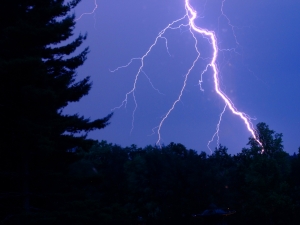AllCampgrounds Hiking Series: Lightning Safety on the Trail
Welcome one and all to AllCampgrounds, where we’ve been learning all about hiking lately.
It’s a great activity that you can combine with tent camping, roughing it in primitive backcountry camp grounds, or just about any other visit to your local park.
No matter where you’re staying, though, the very first thing to be aware of is the weather: and if you’re in an area where lightning is possible, you know that it can whip up suddenly and unexpectedly.
Here are some tips to make sure you stay safe and sound, even if there’s a thunderstorm when you’re well along the trail.
Double-check the weather before you leave: Many camp grounds are equipped with plenty of options for keeping up to date on the outside world, including cable TV, radio, and internet access. If you’re in a public park, the ranger station is your best bet for news on the weather conditions, trail closures, and any dangers that might be looming. Don’t plan to hike on days when the weather will be against you, especially if your trail brings you through backcountry where you may be far from established shelters.
React at the first sign of an oncoming thunderstorm: If you can hear thunder, you’re near enough to be struck by lightning. Listening carefully to thunder in relation to the flash of lightning can tell you how far away the center of the storm is, but not which direction it is moving or how large it is. As soon as you hear the first rumble of thunder, even if it’s quiet or distant, take stock of your surroundings and enact an emergency plan. If you know that you’re close by a safe, well-supplied shelter, turn around. Otherwise, take action based on the surroundings you’re in.
If above the treeline, be extra careful of water: It’s an essential fact that lightning is most likely to strike the tallest object around. Seek out the lowest point you can find, in an open area far from trees; lone trees are more likely to be struck. Make yourself as small as you can by picking a dry spot and squatting down, but don’t lie down! This increases the danger by making you “larger” and widening your point of contact with the ground, which could be wet. Don’t settle in an area with running water or flooding potential.
If below the treeline, take shelter as best you can: Buildings are your best bet in severe weather, and most cars with full roofs are a good alternative. Be aware of dangers like overhangs, lone tall objects that might act as lightning rods, and metal items. If you have no alternative, consider abandoning metal objects, including cell phones, tent poles, cookware, and other items that conduct electricity. Shallow caves that might flood are not safe, but deeper caves might be a safe alternative if you know that you won’t be disturbing animals such as bears or other potential predators.
Whoo! Getting caught out in lightning far from safe camp grounds is a scary thought, but you can minimize the danger by being prepared and keeping a cool head. Remember that, even though a lightning storm can be lethal, about a third of lightning strikes occur at work, not during camping trips; and the odds of being struck by lightning are very low, something like 1 in 84,000! Nature is powerful, but fear is much more likely to put you in harm’s way. Always have a plan!
Thanks for visiting with AllCampgrounds! See you next time with more hiking, camping, and everything else you need outdoors!


